Dinosaurs were the largest reptiles to ever roam the planet. Today, many giant reptiles are related to and remind us of those curious creatures. Currently, crocodiles are the largest reptiles on Earth, but a variety of other reptiles can grow to mind-blowing sizes.
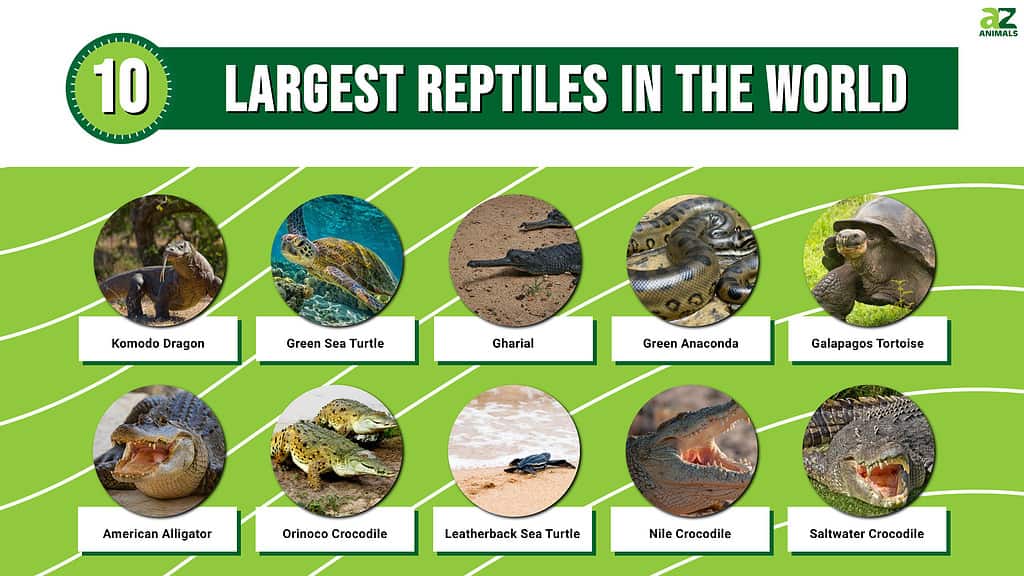
Reptiles, animals of the class Reptilia, encompass turtles, crocodilians, scaled lizards, and tuatara. Reptiles are found in various environments on every continent, excluding Antarctica. They can survive extreme climates and conditions with some seriously cool adaptations.
These dinosaur-like animals can also grow to considerable sizes, much larger than humans. Find out which reptiles take pride as the 10 largest in the world!
Komodo Dragon
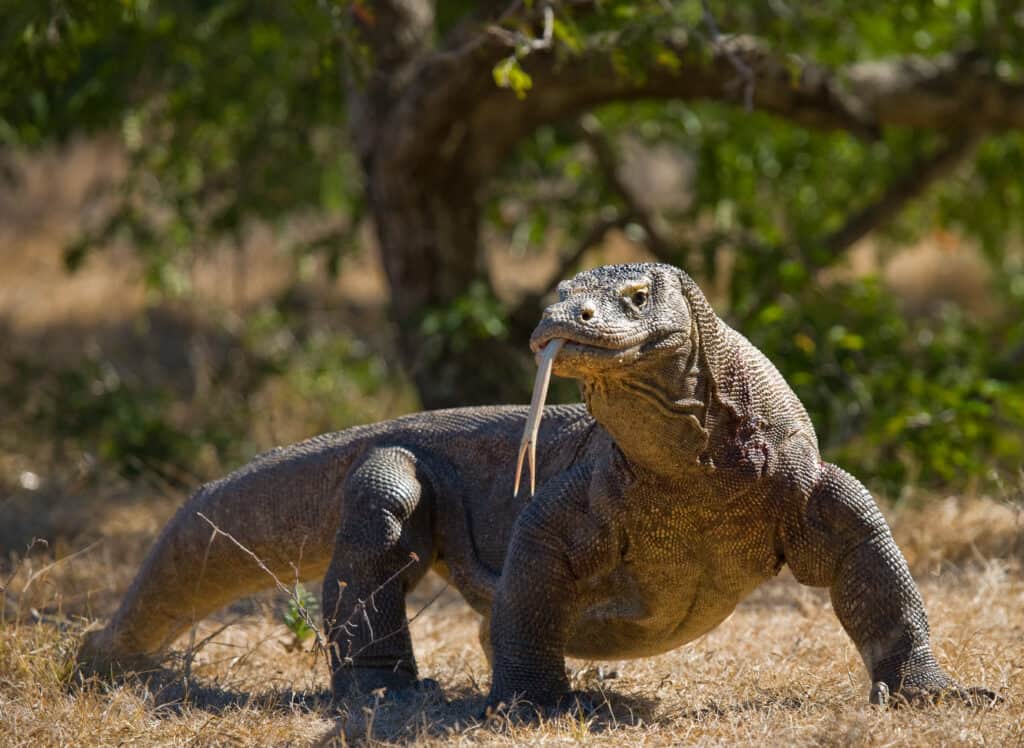
Komodo Dragons grow between 7.5 to 8.5 feet ( 2.2 to 2.5 meters) long and weigh between 150 to 200 pounds (68 to 90.7 kg).
©GUDKOV ANDREY/Shutterstock.com
Lizards are one of the most abundant, and diverse groups of reptiles, and the Komodo Dragons are the largest of them all. Komodo Dragons grow between 7.5 to 8.5 feet ( 2.2 to 2.5 meters) long and weigh between 150 to 200 pounds (68 to 90.7 kg). Males are the larger of the sexes, and the largest Komodo dragon ever recorded was 10.2 feet long, and 365 lbs large.
Komodo dragons are monitor lizards and are effective hunters like the other species in their family. Their size, teeth, venom, and aggressive nature make them one of the most dangerous lizards in the world.
One feature that Komodo dragons have similar to other monitor lizards is the ability to breathe while running, which helps them run down their prey. This trait is something most other lizards can’t do, and they are also native to Indonesia.
Green Sea Turtle

The largest of green sea turtles weighed 871 lbs and was 5 feet long, which is as large as some crocodiles.
©iStock.com/Greg Sullavan
Green sea turtles are one of the largest reptiles in the world and are also the second-largest turtle species. They grow between 3 to 4 feet (0.9 to 1.2 meters) and weigh between 300 to 350 lbs (136 to 158 kg). The largest of green sea turtles weighed 871 lbs and was 5 feet long, which is as large as some crocodiles.
As one of the most well-known turtle species, green sea turtles spend most of their life in the ocean. They feed on aquatic plants near the shores but will travel to land during the breeding season. Green sea turtles are capable of living up to 70 years and are endangered due to overhunting. Normally green sea turtles are found near the shore in tropical waters.
Gharial
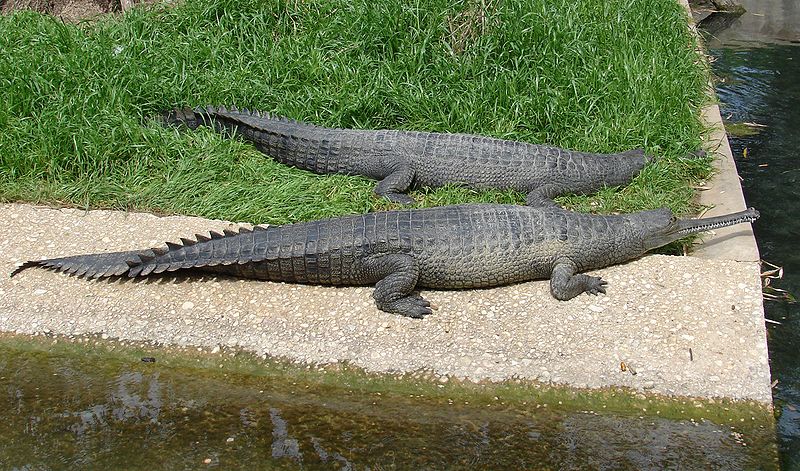
Gharials have a mild tolerance for water with high salinity
©Greverod / Creative Commons – License
Gharials are a large species of crocodilian, with a large elongated snout. On average they weigh 350 lbs (158 kg) and have a length between 8 to 20 ft. Males are larger than females, this species lives in the freshwaters of northern India. The long snout of the gharials is helpful for swimming in the water, and they are able to slightly tolerate water with high salinity.
Fish are the preferred food for this animal, but they are also able to eat other aquatic life like crustaceans, and frogs. Their long snout is good at catching prey, but they are not usually deadly to humans.
Green Anaconda
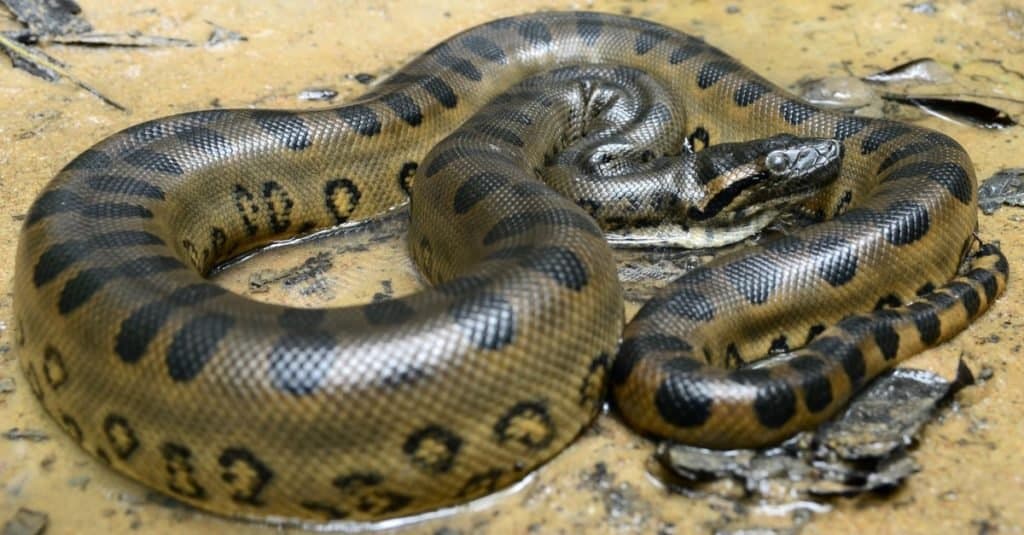
Green anaconda females grow larger than males
©Patrick K. Campbell/Shutterstock.com
The green anaconda is one of the largest snakes in the world when accounting for weight and length. Green anacondas on average grow between 9.8 to 15 ft (2.9 to 4.5 meters), with females being the larger of the sexes. Each snake will vary by weight, but the largest green anaconda ever recorded weighs 550 lbs (227 kilograms), making them the heaviest snake species currently.
Native to the environment of the tropical rainforest in South America, green anacondas are invasive in some tropical areas of the world like Florida.
Green anacondas are often kept as pets but can be dangerous because of their large size and capability to constrict animals. The green anaconda is one of the longest snakes in the world but is beaten by the slightly longer reticulated python.
Galapagos Tortoise
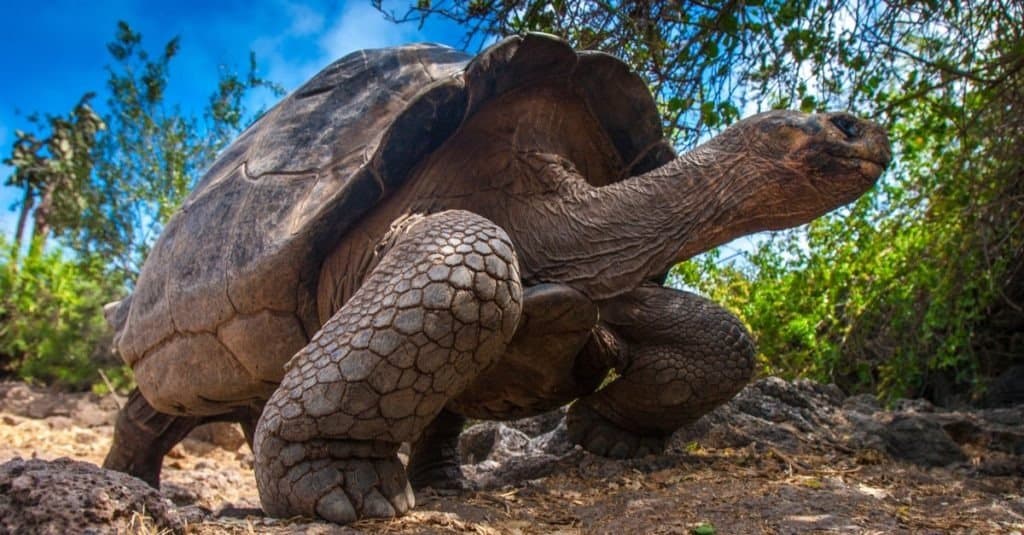
Female Galapagos tortoises are smaller than males but are still on average around 250 lbs (113 kg).
©FOTOGRIN/Shutterstock.com
The Galapagos tortoise is the largest turtle in the world, and they inhabit the Galapagos Islands. Males are the larger sex and can weigh more than 500 lbs (227 kilograms). The largest ever recorded weighed more than 880 lbs (39.9 kg), and measured more than 6 feet. Female Galapagos tortoises are smaller but are still on average around 250 lbs (113 kg).
The destruction of its habitat and poaching by humans is why these giant tortoises are endangered and rare. Around 15,000 are alive today, and conservation efforts like breeding in captivity are how this species is being preserved.
American Alligators
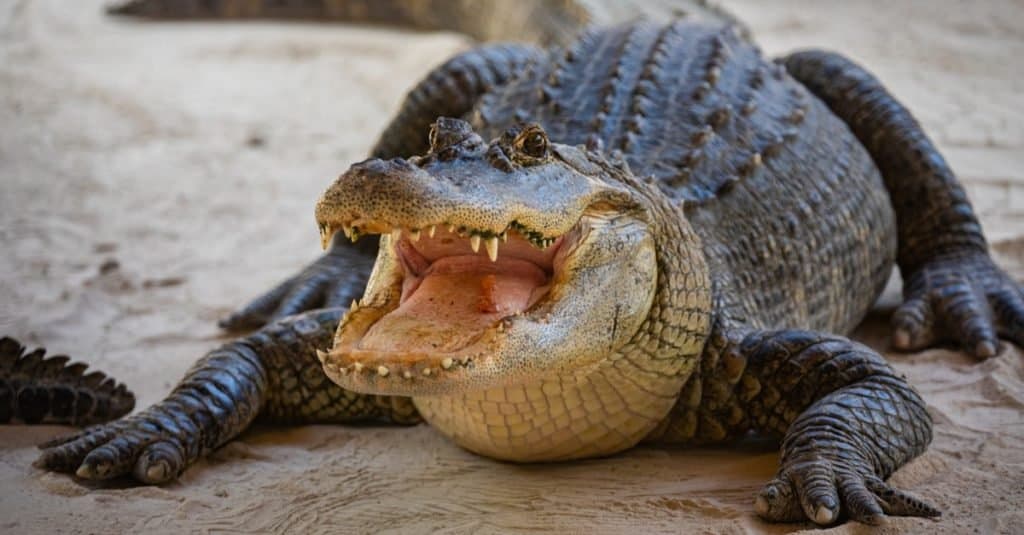
The American
alligator
, which keeps on growing throughout its life, can grow up to 12 feet long and weigh nearly half a ton.
©Mia2you/Shutterstock.com
American alligators are the largest reptile in North America and are threatened in the region it lives in. They look similar to other crocodilians and can grow up to 12 feet in length (3.6 meters). Adult males are the largest type of American alligator and can weigh more than 500 lbs.
American alligators live in the southeast wetlands, marshes, rivers, lakes, and everglade-type habitats. They live in freshwater, and can only tolerate water with higher salt waters for a short period. American alligators are large with sharp teeth. Attacks from them have been deadly in areas where they can be found.
Orinoco Crocodiles
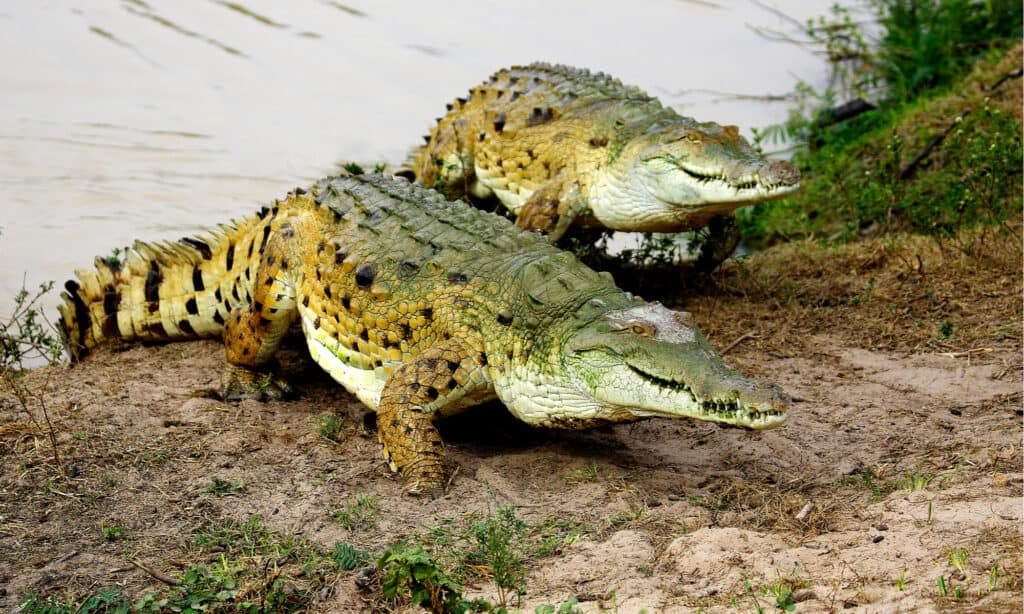
The Orinoco crocodile is critically endangered as a result of having been hunted for its meat and skin
©slowmotiongli/Shutterstock.com
Orinoco crocodiles are a large freshwater crocodile species. Males grow to around 16 feet and weigh about 800 lbs (380kg), while females weigh around 500 lbs (225kg).
This species is found in Columbia and Venezuela. It inhabits slow-moving freshwater habitats like swamps and lagoons. This species is named after the Orinoco Basin in South America since that is where it commonly lived. Used for their teeth, meat, and skin, they have been hunted to near extinction in their range. Orinoco crocodiles are now critically endangered, with around 250 to 1500 left in the wild in the current decade.
Leatherback Sea Turtle

With a size which enables them to brave the chill of ocean currents, leatherback turtles are capable of covering more than 10,000 miles per year
©IrinaK/Shutterstock.com
Leatherback sea turtles are the largest sea turtle in the world and are capable of weighing up to 2,000 lbs. This species lives in the Pacific, Indian, and Atlantic Oceans, and is capable of swimming in depths of 4,000 feet (1,219) in the ocean. Leatherback sea turtles on average grow between 6 to 7.2 ft. (1.8 to 2.1 meters), and males are the larger of the two sexes. As the largest sea turtle in the world, they are known for their smooth, leather-like back.
Their large size is what helps them survive in the ocean’s cold water, and have fat to maintain heat. Leatherback turtles are also one of the most migratory turtle species and will move over 10,000 miles (16093 km) a year. Listed as an endangered species, leatherback sea turtles have been slowly declining in their population. Poaching and habitat loss are the main reasons why leatherback sea turtles have been losing their population.
Nile Crocodile
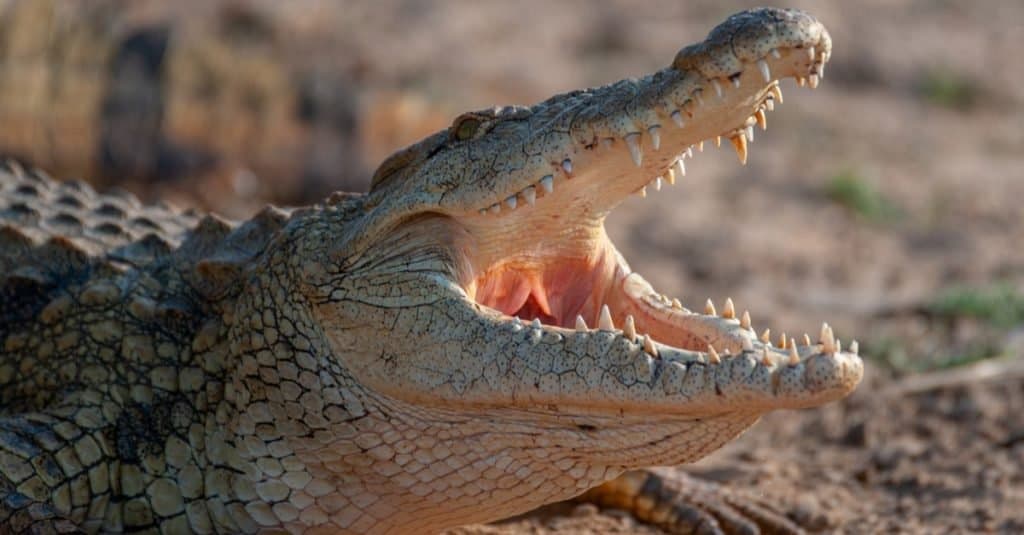
Nile Crocodiles are capable of growing up to 1,700 lbs
©Rudi Hulshof/Shutterstock.com
Nile crocodiles are the second-largest reptiles in the world and also the second-largest crocodilian species. This species of crocodile lives throughout sub-Saharan Africa and the Nile Basin. This giant is a dangerous predator on its land and feeds on fish, zebras, giraffes, and other animals that come near the water. Nile crocodiles are one of the most dangerous reptiles in the world, and new evidence shows this species may even be found in the U.S. and are an invasive species in the Florida Everglades.
In 1905, the largest Nile crocodile ever recorded, growing 21.2 feet long and weighed between 2,300 to 2,400 lbs, showing how large this crocodile could get. On average, Nile crocodiles grow between 7.9 to 14 feet and weigh around 500 to 1,700 lbs. As one of the largest reptiles in the world, they are also one of the most dangerous. It is estimated that they kill more than 100 people a year.
Saltwater Crocodile
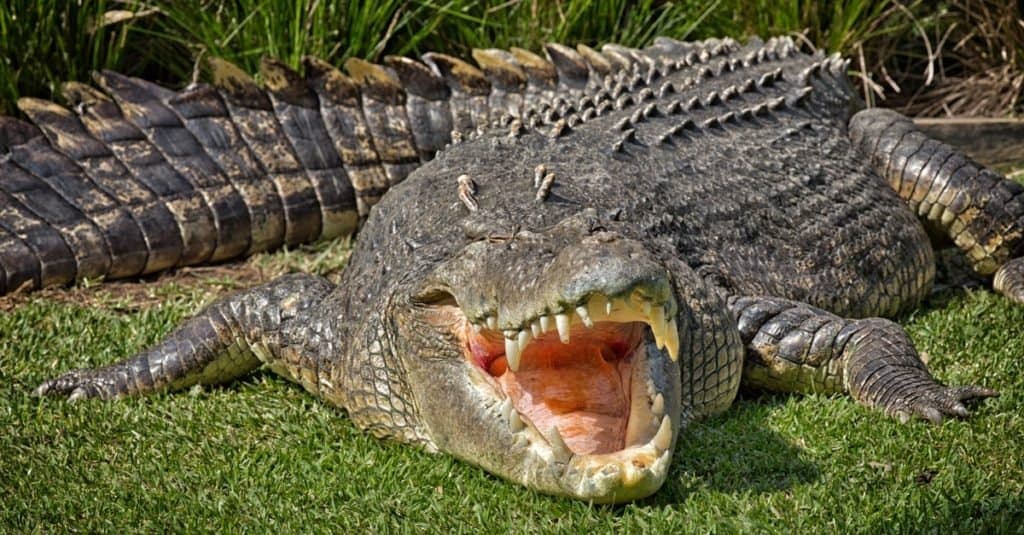
A huge Saltwater Crocodile basks in the hot Australian sun. Saltwater crocodiles are the largest crocodile species and also the largest living reptile in the world.
©PomInOz/Shutterstock.com
The saltwater crocodile is the largest of all the crocodile species and is the largest reptile in the world. On average, saltwater crocodiles are the largest crocodilian species, but sizes will vary. A crocodile’s size can vary due to sex, living conditions, species, and the types of food available to them.
Males are the largest saltwater crocodiles and regularly grow around 20 to 21 feet (6 to 6.3 meters). The biggest saltwater crocodile ever recorded was Lolong, who measured 20.3 feet (6.17 meters) and weighed 2,370 lbs (1,075 kg).
Saltwater crocodiles are the largest crocodile, but other species can occasionally get close to the size of this monster. This species lives in Southeast Asia, eastern India, and parts of Australia. They inhabit freshwaters and get their name from their ability to swim in and tolerate salt and brackish waters. Being the largest reptile in the world, they are also one of the world’s fiercest predators.
Summary: 10 Largest Reptiles In The World

| Rank | Reptile | Average Size |
|---|---|---|
| 10 | Komodo Dragon | 7.5-8.5 feet and 150-200 lbs |
| 9 | Green Sea Turtle | 3-4 feet and 300-350 lbs |
| 8 | Gharial | 8-20 feet and 350 lbs |
| 7 | Green Anaconda | Up to 30 feet and 550 lbs |
| 6 | Galapagos Turtle | 6 feet and 250-500+ lbs |
| 5 | American Alligator | 12 feet and 500+ lbs |
| 4 | Orinoco Crocodile | 16 feet and 500-800 lbs |
| 3 | Leatherback Sea Turtle | 6-7.2 feet and up to 2000 lbs |
| 2 | Nile Crocodile | 7.9-14 feet and 500-1700 lbs |
| 1 | Saltwater Crocodile | 20-21 feet and 1000 lbs |
Honorable Mention
There are several types of crocodiles, so any of them could be listed here, including the American crocodile, the mugger crocodile, and the West Africa slender-snouted crocodile. However, here are some other large reptiles of note:
The Nile monitor can grow up to 7 feet long and weigh nearly 20 pounds. Found throughout most of Sub-Saharan Africa and along the Nile, there is now an invasive population of thousands in North America, especially Florida, probably introduced by the pet trade in the 1990s. These lizards wander over large areas and feed on fish, snails, frogs, snakes, birds, small mammals, insects, carrion and alligator and crocodile eggs and young.
The reticulated python is native to South and Southeast Asia. It is the world’s longest snake, and the third heaviest after the green anaconda and Burmese python. This python is economically important in several countries because it is hunted for its skin, to be sold as a pet, and for use in traditional medicine. It is an excellent swimmer and a non-venomous constrictor. It is an ambush predator that eats small mammals and birds.
The Aldabra giant tortoise is endemic to the Seychelles and native to the Aldabra atoll. It is one of the largest tortoises in the world: it can reach up to 550 pounds (although the maximum recorded was 800 pounds!) and reach about 4 feet in length. Because of its size, it can knock down small trees, making pathways for other animals. This brown or tan tortoise has a high, dome-shaped shell and eats mostly herbs and small shrubs.
The photo featured at the top of this post is ©
Thank you for reading! Have some feedback for us? Contact the AZ Animals editorial team.






